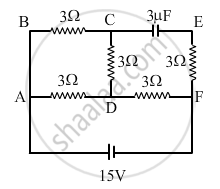Advertisements
Advertisements
Question
In the circuit shown in the figure, find the total resistance of the circuit and the current in the arm AD.

Solution
Since the capacitor will act as an open circuit here, the arm CE and EF will become ineffective. The circuit is now reduced to as below

Effective resistance across AD = (BC + CD) ∥ AD
= \[\left( 3 + 3 \right) \lVert 3 = 2 \Omega\]
Total resistance of the circuit = AD + DF = 2 + 3 = 5 Ω
Total current in the circuit = \[\frac{15}{5} = 3 A\]
The current through AD and BCD will divide in the inverse ratio of the resistance.
∴ Current through AD = \[3 \times \frac{6}{\left( 6 + 3 \right)} = 3 \times \frac{6}{9} = 2 A\]
APPEARS IN
RELATED QUESTIONS
When a 12 V battery is connected across an unknown resistor, there is a current of 2.5 mA in the circuit. Find the value of the resistance of the resistor.
What is Resistivity?
- Draw a V-I graph for a conductor obeying Ohm’s law.
- What does the slope of V–I graph for a conductor represent?
What is an ohmic resistor? Give one example of an ohmic resistor. Draw a graph to show its current voltage relationship. How is the resistance of the resistor determined from this graph?
An electric bulb draws 1.2 A current at 6.0 V. Find the resistance of filament of bulb while glowing.
What is meant by the drift speed of free electrons?
What is ohmic device?
What is non ohmic device?
Write a short note on superconductors?
Two conductors are made of the same material and have the same length. Conductor A is a solid wire of diameter 1 mm. Conductor B is a hollow tube of outer diameter 2 mm and inner diameter 1 mm. Find the ratio of resistance RA to RB.
